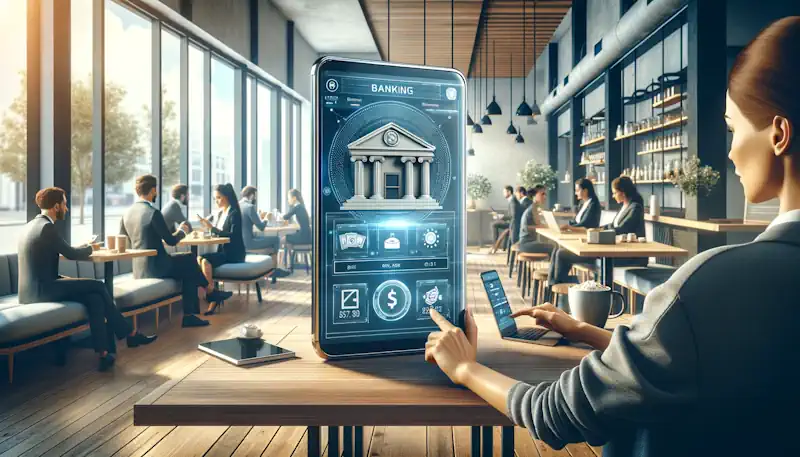Let’s take a moment to explore the fascinating link between mobile commerce and the growth of e-commerce. As our world becomes increasingly interconnected and technology-driven, the influence of mobile commerce on the e-commerce industry cannot be ignored.

What is Mobile Commerce?
Mobile commerce, also known as m-commerce, refers to any transaction or commercial activity conducted through a mobile device, such as a smartphone or tablet. This encompasses a wide range of activities, including online shopping, mobile banking, mobile payments, and mobile advertising. The convenience and accessibility offered by mobile devices have revolutionized the way consumers interact with businesses and make purchases.
Overview of E-commerce Growth
To understand the influence of mobile commerce on e-commerce growth, let’s first explore e-commerce itself. E-commerce, or electronic commerce, is the buying and selling of goods and services over the Internet. Since its inception in the 1990s, e-commerce has experienced exponential growth, transforming the retail landscape and enabling businesses to reach a global audience. The convenience, variety, and competitive pricing offered by online platforms have made e-commerce a preferred choice for many consumers.
The Rise of Mobile Commerce
Mobile Internet Usage Statistics
The rise of mobile commerce can be attributed to the increasing usage of mobile internet. According to statistics, the number of mobile internet users has skyrocketed in recent years, surpassing desktop internet usage. This shift has been fueled by factors such as improved internet connectivity, affordable smartphones, and the availability of mobile data plans. As a result, consumers now have easy access to online shopping and other mobile commerce activities, leading to its rapid growth.
Increasing Smartphone Penetration
Another key factor contributing to the rise of mobile commerce is the increasing penetration of smartphones. Smartphones have become ubiquitous in our daily lives, with a significant portion of the global population owning a smartphone. The convenience and portability offered by smartphones have made them the go-to device for browsing, shopping, and conducting transactions. This widespread adoption of smartphones has opened up new opportunities for businesses to engage with their customers and tap into the mobile commerce market.
Advancements in Mobile Payment Technology
Advancements in mobile payment technology have also fueled the growth of mobile commerce. Mobile wallets, such as Apple Pay and Google Pay, have revolutionized the way consumers make payments. With just a few taps on their smartphones, customers can securely complete transactions, eliminating the need for physical cash or credit cards. This ease of payment has significantly contributed to the success of mobile commerce, enabling seamless and convenient purchasing experiences for consumers.

Mobile Commerce vs. E-commerce
While mobile commerce falls under the broader umbrella of e-commerce, there are distinct differences between the two.
Differences in User Experience
One key difference between mobile commerce and traditional e-commerce lies in the user experience. Mobile commerce is specifically designed for mobile devices, optimizing the user interface and experience for smaller screens. This often involves simplified navigation, responsive design, and touch-friendly interfaces.
On the other hand, traditional e-commerce platforms are primarily designed for desktop or laptop users, offering a more comprehensive browsing and purchasing experience. The distinct user experiences of mobile commerce and e-commerce cater to different consumer preferences and usage patterns.
Advantages and Disadvantages of Mobile Commerce
Mobile commerce offers several advantages over traditional e-commerce. It provides unparalleled convenience, allowing customers to shop anytime and anywhere, even while on the go. Mobile commerce apps often offer personalized recommendations, tailored promotions, and seamless integration with mobile wallets, enhancing the overall shopping experience.
However, one disadvantage of mobile commerce is the limited screen space, which may not always provide the same level of product visibility as traditional e-commerce platforms. Additionally, slower internet speeds or connectivity issues can occasionally hinder the mobile commerce experience.
Impact on E-commerce Sales
The rise of mobile commerce has had a significant impact on overall e-commerce sales. With the increasing popularity of mobile devices, a substantial portion of e-commerce transactions now originate from mobile platforms.
This shift in consumer behavior has prompted businesses to adapt their e-commerce strategies to prioritize mobile compatibility and optimization.
Companies that fail to embrace mobile commerce may miss out on a significant share of the market and lose sales to competitors who have effectively tapped into the mobile commerce trend.
Consumer Behavior and Mobile Commerce
The advent of mobile commerce has had a profound impact on consumer behavior, leading to notable changes in shopping habits, the rise of mobile shopping apps, and an increase in impulse buying.
Shift in Shopping Habits
Mobile commerce has revolutionized shopping habits, empowering consumers with unparalleled convenience and choice. With just a few taps on their smartphones, customers can access a diverse range of products, read reviews, compare prices, and make informed purchase decisions. This shift in shopping habits has also led to an increase in spontaneous purchases, as consumers can easily browse and buy products whenever they feel the desire or need arises.

Rise of Mobile Shopping Apps
Mobile shopping apps have become increasingly popular, offering dedicated platforms for mobile commerce. These apps provide a seamless and personalized shopping experience, often incorporating features such as saved payment details, push notifications for promotions or discounts, and easy access to order history.
The rise of mobile shopping apps has further facilitated the growth of mobile commerce, providing a convenient and user-friendly interface for consumers to explore and purchase products.
Mobile Commerce and Impulse Buying
Mobile commerce has also contributed to an increase in impulse buying. The convenience and accessibility of mobile shopping make it easier for consumers to succumb to impulsive purchases. With just a few taps, customers can instantly buy products that catch their attention, often driven by persuasive product recommendations, limited-time offers, or influential social media content.
The rise of impulse buying in mobile commerce presents both opportunities and challenges for businesses to effectively tap into this consumer behavior and optimize their marketing strategies.
Mobile Commerce and Social Media
Social media platforms have become integral to the mobile commerce landscape, influencing purchase decisions and driving customer engagement.
Integration of Social Media Platforms
Mobile commerce platforms have increasingly integrated social media functionalities, allowing customers to seamlessly share products, reviews, and recommendations with their social networks.
This integration enhances the shopping experience by enabling customers to seek advice from friends, discover new products through targeted advertisements, and engage with brands directly on social media platforms.
The integration of social media and mobile commerce has created a symbiotic relationship, with each complementing and amplifying the other’s impact.
Social Media Advertising and Mobile Commerce
Social media advertising has emerged as a powerful tool for businesses in mobile commerce. Platforms like Facebook, Instagram, and Twitter provide targeted advertising options, allowing businesses to reach their desired audience effectively.
By leveraging user data and preferences, businesses can create personalized advertisements that resonate with individual customers, driving engagement, and ultimately, sales.
The ability to seamlessly transition from social media platforms to mobile shopping apps further facilitates the path to purchase, enhancing the overall mobile commerce experience.
Influence of Social Media on Purchase Decisions
Social media platforms have a significant influence on purchase decisions in mobile commerce. Users often rely on social media content, such as product reviews, influencer recommendations, and user-generated content, to inform their buying decisions.

The ability to access real-time feedback, engage in discussions, and receive personalized recommendations significantly impacts consumer behavior.
Brands that actively engage with customers through social media platforms and cultivate positive online communities can leverage this influence to drive conversions and build customer loyalty.
Mobile Commerce and Personalization
Personalization is a key aspect of the mobile commerce experience, enhancing customer satisfaction, and increasing the likelihood of repeat purchases.
Personalized Product Recommendations
Mobile commerce platforms excel in providing personalized product recommendations based on individual customer preferences, browsing history, and purchase behavior.
By leveraging artificial intelligence and machine learning algorithms, businesses can analyze vast amounts of data to offer highly targeted and relevant product suggestions. This not only simplifies the shopping process for customers but also increases the chances of discovering new products that align with their interests and needs.
Customized Shopping Experience
Mobile commerce platforms have the ability to offer a customized shopping experience tailored to each individual customer. This includes features such as personalized promotions, customized user interfaces, and the ability to save payment and shipping information for future purchases.
The seamless integration of mobile wallets and loyalty programs further enhances the customizability, enabling customers to have a streamlined and hassle-free shopping experience.
By providing a personalized and convenient experience, businesses can foster customer loyalty and differentiate themselves in a competitive mobile commerce landscape.
Effect on Customer Loyalty
Effective implementation of personalization strategies in mobile commerce can significantly impact customer loyalty.
By consistently delivering personalized recommendations, personalized promotions, and a tailored shopping experience, businesses can foster a strong sense of customer loyalty and repeat purchases.
The convenience and satisfaction derived from a personalized mobile commerce experience can create a lasting impression on customers, leading to increased customer retention and advocacy.
Mobile Commerce and Omnichannel Retailing
Mobile commerce has played a crucial role in the evolution of omnichannel retailing, seamlessly integrating online and offline channels to enhance the customer journey.
Integration of Online and Offline Channels
Mobile commerce acts as a bridge between online and offline channels, allowing consumers to seamlessly switch between the two. A customer can begin their shopping journey on their smartphone, browse products online, and make a purchase. They can then choose to pick up their purchase in-store, offering the convenience of online shopping with the immediacy of an offline experience.

This integration of channels provides customers with the flexibility to choose their preferred method of interaction and enables businesses to deliver a cohesive and consistent experience across multiple touchpoints.
Enhanced Customer Journey
Mobile commerce enhances the customer journey in omnichannel retailing by providing convenience, personalization, and a seamless shopping experience.
Mobile apps and websites offer features such as saved shopping carts, synchronized wish lists, and personalized promotions, ensuring that customers can continue their journey seamlessly across devices and channels.
By eliminating friction points and providing a consistent experience, businesses can enhance customer satisfaction and encourage repeat purchases.
Challenges for Retailers
While mobile commerce presents numerous opportunities for retailers in the realm of omnichannel retailing, it also poses challenges. Retailers must ensure their online platforms are optimized for mobile devices, offering intuitive navigation, responsive design, and secure payment options.
Managing inventory across different channels and providing real-time product availability can also be a logistical challenge. Additionally, retailers must effectively leverage customer data to provide personalized experiences across platforms, ensuring a cohesive and seamless journey that exceeds customer expectations.
Future Trends in Mobile Commerce
The future of mobile commerce holds exciting developments that promise to shape the way we shop and engage with businesses. Some notable trends to watch out for include the growth of augmented reality in mobile shopping, voice-activated mobile commerce, and the rise of mobile wallets.
Growth of Augmented Reality in Mobile Shopping
Augmented reality (AR) technology offers a unique and immersive shopping experience in the mobile commerce landscape. By overlaying virtual objects onto the real world, customers can visualize products in their physical environment, allowing for better decision-making and reducing the likelihood of returns.
AR technology has the potential to transform how customers interact with products, particularly in industries such as furniture, fashion, and home decor, where visualizing the product in real-world settings is crucial.
Voice-Activated Mobile Commerce
Voice-activated mobile commerce, powered by voice assistants like Siri, Alexa, and Google Assistant, is gaining momentum. The ability to make purchases, check product availability, and track orders through voice commands offers a hands-free and convenient shopping experience.
As voice recognition technology continues to improve, more consumers are expected to embrace this seamless and intuitive way of shopping in the future.
Rise of Mobile Wallets
Mobile wallets are expected to become increasingly popular in the future of mobile commerce. With secure and efficient payment processes, mobile wallets eliminate the need for physical cash or credit cards, providing a streamlined and convenient payment solution.

The integration of mobile wallets with loyalty programs, rewards, and personalized promotions further enhances the mobile commerce experience. As technology continues to advance, mobile wallets are anticipated to become the go-to payment method for mobile commerce users.
Summing Up
Mobile commerce has had a significant impact on the growth of e-commerce. Its rise can be attributed to the increasing usage of mobile internet, the widespread adoption of smartphones, and advancements in mobile payment technology.
Mobile commerce differs from traditional e-commerce in terms of user experience, advantages and disadvantages, and its impact on overall e-commerce sales.
The influence of mobile commerce on consumer behavior, social media integration, personalization, and omnichannel retailing cannot be understated.
Additionally, future trends such as augmented reality, voice-activated mobile commerce, and the rise of mobile wallets indicate exciting developments on the horizon.
As mobile commerce continues to evolve, businesses must adapt their strategies to capitalize on the opportunities and navigate the challenges that arise in this dynamic landscape.
By prioritizing mobile optimization, personalization, and seamless integration with other channels, businesses can position themselves for success in the continuously evolving world of mobile commerce.

